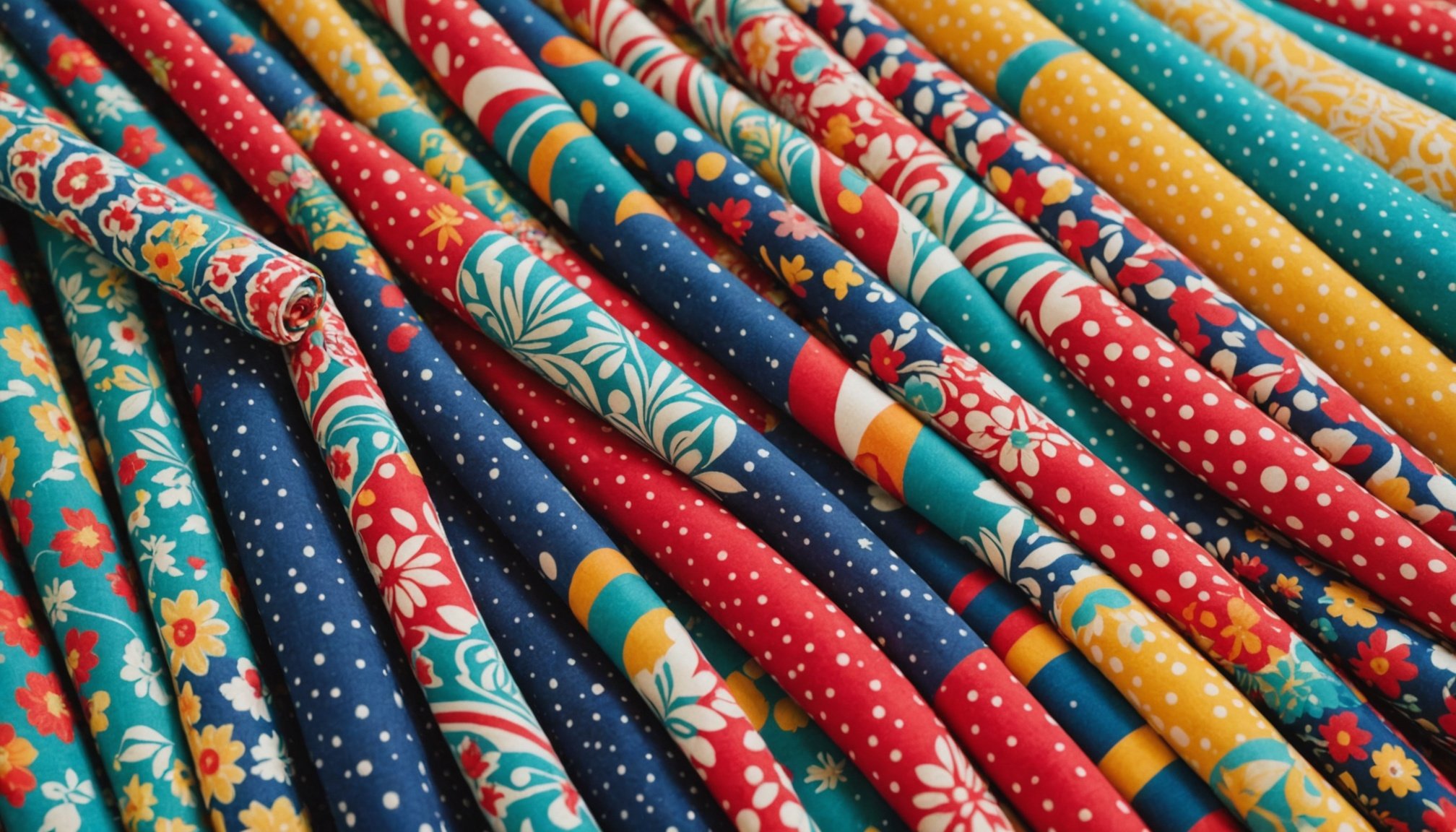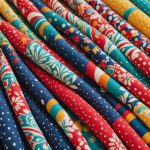Overview of Fabric Types for Dresses
When considering fabric types for dresses, the UK dressmaking scene often gravitates towards classics like cotton, linen, silk, and chiffon. Each of these fabric types boasts unique characteristics making them suitable for diverse styles and purposes.
Cotton, for instance, is favoured for its breathability and versatility, making it ideal for casual and summer dresses. It’s generally affordable and easy to sew, lending itself well to beginners. Linen, on the other hand, offers a natural, textured look and exceptional coolness—perfect for warm climates. However, its tendency to wrinkle is a common downside.
Also to read : Enhance Your Closet: Chic Styling Hacks for the Classic British Trench Coat
Silk, an epitome of luxury, exudes elegance and softness, making it a popular choice for evening and formal dresses. Despite its alluring sheen, silk can be pricey and tricky to work with, often requiring delicate handling. Chiffon, known for its lightweight and flowing nature, is ideal for layering and adding an airy volume to garments, though it does demand careful sewing techniques.
Understanding these pros and cons aids in fabric selection and assists dressmakers in balancing aesthetics with practicality when creating handmade dresses. These foundational fabrics continue to inspire beautiful creations across the UK.
Also read : Find the Ideal Wool Gloves for a Snug UK Winter: The Definitive Guide
Overview of Fabric Types for Dresses
Understanding the different fabric types for dresses and their characteristics is essential for anyone venturing into dressmaking. Common choices in the UK include cotton, linen, silk, and chiffon. Each of these materials offers unique attributes that can heavily influence a handmade dress’s finish.
Cotton is highly favoured for its breathability and ease of maintenance, making it ideal for casual summer dresses. However, it can lack the elegance required for more formal attire. On the other hand, linen is perfect for its lightweight and airy feel but does tend to wrinkle, affecting the polished look.
For those seeking luxury, silk is unparalleled in its softness and natural sheen. However, it requires delicate care and handling, which can be a downside for novice dressmakers. Chiffon adds a whimsical touch to any dress, contributing to a floaty, ethereal appearance but may be challenging to sew due to its slippery texture.
Choosing the right dressmaking fabrics involves weighing these pros and cons to match the fabric selection with the intended style and occasion. Opting for the appropriate fabric can transform the dressmaking process, leading to a successful and satisfying sewing experience.
Factors to Consider When Selecting Fabric
When it comes to fabric selection, evaluating the style and purpose of your dress is crucial. The fabric should not only match the aesthetic but also meet the functional needs of the garment. For instance, a flowing evening gown might prioritize elegance over durability, whereas a casual summer dress may require breathability.
Understanding fabric characteristics is essential. Consider the weight, which impacts the structure and drape of the garment. Lightweight fabrics like cotton are ideal for casual wear, while heavier materials such as wool provide structure. The drape of fabric determines how it falls on the body; silk’s natural fall, for instance, offers effortless elegance. Additionally, assess texture; consider how it feels on the skin, as linen’s texture provides comfort in warm weather.
When choosing colours and patterns, aim for what enhances your dress design. Neutral tones often suit a wide range of occasions, but a vibrant pattern can make a statement piece. Evaluate the fabric’s interaction with your skin tone and the intended event’s formality to ensure a cohesive look. Thus, a thorough understanding of these aspects will elevate your dressmaking projects.
Factors to Consider When Selecting Fabric
Understanding the nuances of fabric selection is vital in creating a dress that meets both style and practical needs. Dress style and purpose play a pivotal role in this process. For instance, a formal evening gown may require luxurious fabrics like silk, while a casual summer dress might benefit from breathable cotton. Each fabric’s weight, drape, and texture significantly influences the final appearance and comfort of the dress.
When choosing fabric, it’s essential to assess the fabric’s weight for suitability—the lighter the weight, the more airy and relaxed the dress will feel. The drape dictates how a fabric hangs on the body, affecting movement and overall style. Texture adds an extra dimension to the design, impacting both aesthetic and tactile experiences.
Colours and patterns also enhance the final design and should align with the dress’s intended occasion. Vibrant patterns can add flair to casual attire, while solid, muted tones often suit formal settings. Thoughtful fabric selection tips ensure the outcome reflects the maker’s creative vision and meets wearer expectations, resulting in a handmade masterpiece.
Local Resources for Purchasing Fabrics in the UK
Navigating through the vast array of UK fabric suppliers can seem overwhelming, but fear not! A visit to renowned fabric shops in major cities often reveals gems such as Liberty of London, admired for its iconic prints, and The Fabric Store, known for its high-quality fabrics. These fabric suppliers offer a wide array of textiles, meeting needs for every dressmaking project.
For those who prefer the comfort of shopping from home, numerous reputable online fabric retailers cater to diverse customer preferences. Websites like Minerva and Fabric Godmother provide extensive selections and deliver straight to your doorstep.
A Sustainable Dress Approach: Sustainable practices are becoming more prevalent, with an increase in demand for ethically produced and environmentally friendly textiles. Sourcing from vendors that prioritise these ethical standards ensures your dressmaking journey is conscious of both style and the planet.
Meanwhile, local markets, often nestled in communities, offer an array of unique fabrics. Here you can find limited-quantity materials—perfect for a distinctive, handmade touch. Understanding the best places to buy fabrics in the UK can transform your fabric selection process into a truly enjoyable experience.
Local Resources for Purchasing Fabrics in the UK
When exploring UK fabric suppliers, dressmakers have a diverse range of options. Several well-known fabric stores are scattered across major cities, each with its own charm and speciality. In London, places like The Cloth House and Berwick Street Cloth Shop offer extensive selections catering to both everyday and luxury dressmaking needs. Meanwhile, Liberty London provides a more artisanal experience, famous for its unique prints.
For those preferring online shopping or not based near cities, sites like Minerva Crafts and Eternal Maker offer comprehensive collections and deliver nationwide. They often provide valuable resources like inspiration boards to assist in fabric selection.
Local markets, such as those found in Brick Lane or Manchester’s Northern Quarter, provide a vibrant atmosphere and opportunities to discover unique and often sustainable fabric choices.
For the eco-conscious dressmaker, sourcing sustainable and ethical fabric options can be achieved through shops like Offset Warehouse, which specialises in environmentally friendly and fair-trade fabrics. This approach not only enriches the creative process but also supports ethical fashion practices. By leveraging these resources, dressmakers can effortlessly procure a diverse range of textiles.
Expert Tips for Fabric Care and Maintenance
To prolong the life and beauty of your dress fabrics, understanding proper fabric care is crucial. Begin with washing guidelines. Silk and chiffon require gentle handling; hand wash with mild detergent and air dry, avoiding direct sunlight. Cotton and linen, being more robust, can typically handle machine washing on a gentle cycle.
When it comes to drying, air drying is best for preserving fabric quality. Avoid tumble dryers, especially for delicate materials, as heat can damage fibers. For storing fabrics, keep them in a cool, dry place, away from direct sunlight and moisture, which can lead to fading or mildew.
Repairing and upcycling can be a creative solution to extend the life of fabric remnants. Small tears can be mended with sewing patches, while outdated designs can be transformed into fresh, stylish pieces. Consider using fabric snippets in crafts or accessories, offering a sustainable approach to fabric maintenance.
By implementing these practices, you ensure your handmade dresses remain in excellent condition, ready to impress on any occasion. Remember, the right care enhances both the fabric’s longevity and your satisfaction with each sewing project.
Expert Tips for Fabric Care and Maintenance
Proper fabric care is essential to preserve the quality and longevity of your handmade dresses. Begin with understanding the best practices for handling different fabric types. For instance, cotton fabrics are generally robust and can endure regular machine washes, while the delicate nature of silk necessitates hand washing or dry cleaning to maintain its luxurious sheen.
When it comes to drying, air drying is often recommended to prevent shrinkage and potential heat damage. Heavier fabrics like linen might require pressing with a warm iron to manage wrinkles effectively. Always check specific fabric cleaning instructions to avoid mishaps.
Appropriate storage conditions significantly influence fabric maintenance. Store dresses in a cool, dry place, ideally in breathable garment bags to allow airflow yet prevent dust accumulation. This is particularly vital for chiffon and other lightweight materials prone to snagging or creasing.
For those looking to make the most of fabric remnants, consider upcycling techniques. Small swatches can transform into beautiful patchworks, accessories, or embellishments for other garments, contributing to sustainable dressmaking practices while reducing waste.
Suggested Patterns for Different Dress Styles
Navigating the world of dress patterns can be thrilling as it unlocks endless handmade dress ideas. Different styles require unique considerations. For instance, a flowing maxi dress pairs beautifully with lightweight fabrics like chiffon to enhance its ethereal movement. Meanwhile, structured sheath dresses benefit from the crispness of fabrics such as cotton, providing a sleek, polished look.
Choosing sewing patterns that align with fabric characteristics is crucial. Consider the drape and weight of the fabric: A fitted wrap dress pattern works well with materials like linen, allowing for a relaxed yet tailored fit. For a luxurious touch, opt for classic A-line patterns with silk, which drapes elegantly and adds a sophisticated sheen.
Here are some successful combinations:
- Shift Dresses in cotton for comfortable daywear.
- Empire Waist Gowns with chiffon for an elevated evening look.
- Fit-and-Flare Dresses using silk for special occasions.
By aligning dressmaking fabrics with design elements, the final piece reflects both artistry and practicality. Exploring these patterns and fabric pairings empowers dressmakers to create stunning, personalised garments.
Suggested Patterns for Different Dress Styles
The right blend of dress patterns and fabric types is key to turning fabric into a stunning dress. To enhance your creations, consider both the style you aim to achieve and the properties of your chosen material.
Dress Styles and Fabric Compatibility
Popular styles often influence fabric selection. An A-line dress, for example, benefits from the lightweight, breathable nature of cotton, providing ease and comfort while retaining structure. For glamorous evening gowns, silk suits the luxurious aesthetic, gracefully highlighting the garment’s lines due to its natural sheen and flow.
Choosing Patterns Based on Fabric Characteristics
Consider the fabric’s drape, weight, and texture when selecting sewing patterns. Linen, with its weight and texture, perfectly complements relaxed-fitting patterns like shift dresses, ideal for casual outings. Chiffon’s fluidity harmonises with flowy, tiered designs, adding a whimsical, layered dimension to your attire.
Successful Fabric and Pattern Combinations
To inspire your creative process, examples like a cotton floral sundress or a silk slip gown illustrate adept combinations of material and pattern. Crafting such garments involves aligning the inherent features of the fabric with the desired silhouette, ensuring a cohesive and stylish result every time.
Visual Inspiration and Examples
Visuals can provide a deep well of dressmaking inspiration, especially when considering different fabric examples. Examining photos of dresses crafted from various materials helps illustrate how each fabric type influences design.
Case studies offer insight into successful pairings of fabric and dress style. For instance, a light, embroidered cotton sundress might be highlighted for its combination of comfort and style. Another example might show a sleek silk evening gown, demonstrating the fabric’s graceful drape and sheen, perfect for formal occasions.
Visual guides are also invaluable tools. These could include side-by-side comparisons of dresses crafted from linen, showcasing its texture, alongside similar silhouettes in chiffon, highlighting its airy, flowing nature.
These resources not only spark creativity but help clarify crafting examples for aspiring dressmakers. By visually aligning dress patterns with their ideal dressmaking fabrics, creators can more easily envision the end result. Emphasising fabric examples in imagery aids in the decision-making process, ensuring that the choice of material matches both the intended design and the practical requirements of wear.











